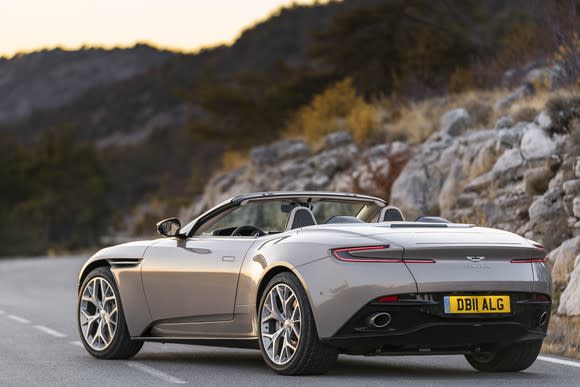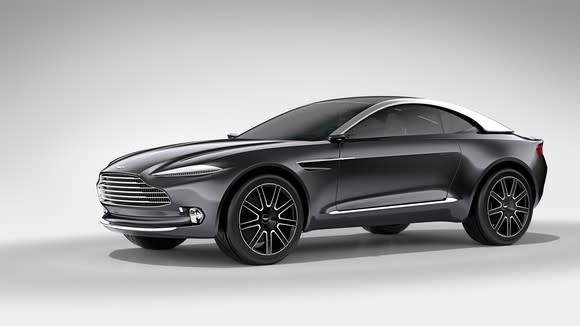Aston Martin's Profit Slips as IPO Question Lingers
British supercar maker Aston Martin said this week that its pre-tax profit fell by more than half in the first quarter of 2018 from a year ago, to 2.8 million British pounds ($3.7 million as of May 24, 2018), on a weaker U.S. dollar and higher spending on new-product launches.
Aston Martin has never been a public company, but it could be soon. The company raised the possibility of an IPO after posting a solid profit for 2017. Given the steep rise in rival Ferrari's (NYSE: RACE) stock price since its IPO in late 2015, an Aston Martin IPO could be of considerable interest to investors.
But as a business, how does Aston Martin compare to Ferrari? Let's take a closer look.

A new convertible version of Aston Martin's DB11, called the DB11 Volante, is powered by a V-8 engine supplied by Mercedes-Benz. Image source: Aston Martin Holdings Ltd.
The raw numbers
We don't have complete first-quarter results for Aston Martin, just the summary it released to the general public and a few additional details that were reported by Reuters. But we can use what we have to get a general idea of how Aston compares to Ferrari as a business by comparing its first-quarter results to Ferrari's.
Note that Aston Martin reports its results in British pounds, and Ferrari in euros. For the sake of comparison, I've converted Aston's results to euros, using the rate in effect as of May 21: 1 British pound equals about 1.14 euros.
Metric | Aston Martin Q1 2018 | Ferrari Q1 2018 |
|---|---|---|
Revenue | 211.4 million euros | 831 million euros |
Vehicles shipped | 963 | 2,128 |
Adjusted EBITDA | 49.8 million euros | 272 million euros |
Adjusted EBITDA margin | 24% | 32.7% |
Pre-tax profit | 3.19 million euros | 206 million euros |
Data sources: Aston Martin Holdings Ltd., Ferrari N.V. "Adjusted" figures exclude one-time items. "EBITDA" is earnings before interest, tax, depreciation, and amortization.
About Aston Martin's business
Aston Martin's model range can be bewildering, but if we step back we see that the company's cars fall into five categories. Generally speaking, as the price rises, so does the profit margin -- but most Astons sold are in the first three categories:
A two-seater positioned as a rival to sports cars like Porsche's 911. The current model is the Vantage, starting around $150,000.
A sleek coupe (or convertible) with a small back seat, positioned as a fast, luxurious sports-touring car -- what most car enthusiasts think of when they think of an Aston Martin. Right now, this is the DB11, which starts just under $200,000. (Most classic Aston Martins fall into this category.)
A four-door with low-slung coupe styling: the Rapide, starting around $205,000.
A more aggressively tuned high-performance coupe-with-a-small-back-seat: the Vanquish, starting at just under $300,000.
Occasional super-fast, super-expensive limited-run models that sell for $1 million or more (sometimes a lot more).

Aston Martin's DBX show car previewed an upcoming SUV model. Image source: Aston Martin Holdings Ltd.
CEO Andy Palmer has said that Aston will expand its product line into (at least) two more segments over the next few years:
An Aston Martin-branded SUV, which might appear next year and might be named "Varekai."
An all-electric high-end luxury sedan or SUV (or possibly both) under the Lagonda brand, an old sedan brand that Aston has owned for many years. It's likely to arrive in 2021 or 2022.
What the Ferrari comparison tells us about Aston Martin
First and foremost, Aston Martin is a considerably smaller company than Ferrari. But in truth, it's somewhat bigger than that first-quarter sales total would suggest. Aston's first-quarter shipments were down 20% from the year-ago period because ongoing changeovers to new models, including an all-new Vantage and a convertible (or "Volante," in Aston-speak) version of the DB11, reduced its production output. Demand remains strong, though: Aston said that its order book for 2018 continues to exceed its overall production capacity.
Aston Martin is also less profitable than Ferrari. While the company didn't give us quite enough information to estimate its operating income, it's clear from its EBITDA that it's not quite in Ferrari's league when it comes to margins. To be fair, not many auto-related companies are: Ferrari's operating margin in the first quarter was 25.3%, a testament to its extraordinary pricing power.

The Aston Martin V8 Vantage, the company's biggest seller, is all-new for this year. Reviews have been very positive. Image source: Aston Martin Holdings Ltd.
Most large automakers would consider 10% to be an extremely good result. For comparison, General Motors' automotive segment reported an adjusted operating margin of 7.2% in the first quarter, while BMW AG's was 9.7% -- and these are two of the better-run large automakers.
Simply put, Ferrari's margin is more like a luxury-goods company's than like a traditional automaker's -- as is its valuation, currently around 38 times earnings. Should Aston Martin go public, the big question on investors' minds will be this: How close can it get to Ferrari's profitability?
When we know that answer, we'll have a pretty good idea of what Aston could be worth. Stay tuned.
More From The Motley Fool
John Rosevear owns shares of General Motors. The Motley Fool has no position in any of the stocks mentioned. The Motley Fool has a disclosure policy.

